International Journal of Geosciences, 2019, 10, 1-11
http://www.scirp.org/journal/ijg
ISSN Online: 2156-8367
ISSN Print: 2156-8359
A Review of Researches on Deep Learning in
Remote Sensing Application
Ming Zhu1,2*, Yongning He2, Qingyu He2
1Institute of Geoscience and Resources, China University of Geosciences, Beijing, China
2Geographic Information Center of Guangxi, Nanning, China
How to cite this paper: Zhu, M., He, Y.N.
and He, Q.Y. (2019) A Review of Re-
searches on Deep Learning in Remote
Sensing Application. International Journal
of Geosciences, 10, 1-11.
https://doi.org/10.4236/ijg.2019.101001
Received: December 18, 2018
Accepted: January 7, 2019
Published: January 10, 2019
Copyright © 2019 by author(s) and
Scientific Research Publishing Inc.
This work is licensed under the Creative
Commons Attribution International
License (CC BY 4.0).
http://creativecommons.org/licenses/by/4.0/
Open Access
Abstract
In recent years, deep learning has been widely used in the field of image un-
derstanding and made breakthroughs research progress in image under-
standing. Because remote sensing application and image understanding are
inseparable, researchers have carried out a lot of research on the application
of deep learning in remote sensing field, and extended the deep learning me-
thod to various application fields of remote sensing. This paper summarizes
the basic principles of deep learning and its research progress and typical ap-
plications in remote sensing, introduces the current main deep learning mod-
el and its development history, focuses on the analysis and elaboration of the
research status of deep learning in remote sensing image classification, object
detection and change detection, and on this basis, summarizes the typical ap-
plications and their application effects. Finally, according to the current ap-
plication of deep learning in remote sensing, the main problems and future
development directions are summarized.
Keywords
Deep Learning, Remote Sensing Application, CNN, Land Cover Classification,
Object Detection, Change Detection
1. Introduction
Remote sensing is a technical means using sensors on satellite, aircraft or other
platforms to collect targets’ radiation information, with which specific informa-
tion can be obtained. In recent years, with the rapid development of remote
sensing technology, the capacity of acquiring remote sensing data has been en-
hancing. Meantime, the spectral, spatial and temporal resolution of remote
sensing imagery have been improving [1], providing solid data bases for the re-
DOI: 10.4236/ijg.2019.101001 Jan. 10, 2019
1
International Journal of Geosciences
�
M. Zhu et al.
DOI: 10.4236/ijg.2019.101001
mote sensing application. Although better and better imagery can be acquired
through remote sensing, in practice the application of remote sensing imagery
relies heavily on manual processing, while machine interpretation is only an aid
to manual work. Traditionally, machine interpretation of remote sensing im-
agery is achieved through statistical methods such as maximum likelihood and
K-means clustering, which are based on remote sensing features like spectrum
and textures. In the past few years, methods including artificial neural network,
support vector machine, genetic algorithm and object oriented method are de-
veloping rapidly with certain fruits achieved [2]. However, generally speaking,
all these methods require manually extraction of image features or design of in-
terpretation rules, thus lead to long design cycles and limited the potential of al-
gorithm improvement. Besides, the accuracy and efficiency of automatic inter-
pretation of remote sensing imagery cannot meet the needs of most applications.
Since the remote sensing application is heavily dependent on manual work, the
effectiveness of remote sensing is severely restricted by the experience and ex-
pertise of the operator [3].
Deep learning is an important domain of machine learning research. Com-
pared with traditional machine learning, deep learning is a representation-
learning method with multiple layers. Data abstraction and extraction from the
lower layers to higher layers are accomplished through simple nonlinear mod-
ules. Current deep learning often use deep neural network (DNN) to construct
the layers, which are the stacks of simple nonlinear modules. Input data is passed
between the layers, whose mapping relationship reduces the dimension and ex-
tract the key characteristics of data [4]. Relying on the deep convolution neural
network (DCNN), deep learning provides an end-to-end machine learning
model that can automatically extract image features without extraction algo-
rithms designed by human. Compared with traditional methods, deep learning
is completely data-driven, which can automatically find the best ways to extract
image features through learning [5] [6].
This paper briefly introduces the development of deep learning, and makes a
detailed analysis for the current application fields of remote sensing land cover
classification, target detection and change detection, expounds the main deep
learning methods and research progress in these three fields, introduces the cur-
rent application situation of deep learning in remote sensing field, and summa-
rizes the current research work and main models. Finally, the application of
deep learning is, summarized the existing problems are pointed out, and the fu-
ture development direction of deep learning for remote sensing is prospected.
2. Common Deep Learning Methods
in Remote Sensing Application
The deep learning method in remote sensing application is mainly used in three
aspects, namely surface classification, object detection and change detection. A
review of the current research results indicates that the major technical approach
2
International Journal of Geosciences
�
M. Zhu et al.
is to translate specific problems into classification or object detection tasks,
which are processed with the computer vision deep learning model that is rede-
signed and adjusted for the targets of the remote sensing application, thus the
specific problems are solved. The main structure is shown in Figure 1.
2.1. Land Cover Classification Methods of Remote Sensing Image
Land cover classification is a major field of remote sensing application. The
main task of surface classification is to divide the pixels or regions in remote
sensing imagery into several categories according to application requirements
[7]. The deep learning model of land cover classification is generally based on
deep belief network (DBN), convolution neural network (CNN) and spare auto
encoder (SAE), among which the deep convolution neural network is the most
popular approach at present.
Many early studies used deep CNN as Alexnet and VGG Net and achieved cer-
tain results. However, the nature of Alexnet and VGG Net classification method is
to transform an image into a corresponding eigenvector through convolution,
pooling and fully connected layer. Based on the eigenvector, a value representing
the image classification is output. Therefore, the major issue addressed with such
approach is the classification of integrated imagery on the image level. However,
land cover classification is a problem of image segmentation, what to be addressed
is the multi-classification after semantic segmentation of a single image.
To solve the problem of semantic segmentation and multi-classification, Long,
et al. proposed FCN [8], the full convolution neural network based on semantic
segmentation. Based on CNN, FCN substitutes all the pooling layers and fully
connected layers with convolution layers. At the end of the network, FCN in-
troduces the transposed convolution layer, which upsamples the image features
and predicts the output image size according to the input image size, thus every
input pixel is predicted and the image is classified. FCN realizes end-to-end se-
mantic segmentation, but it performs not that well in edge processing and classi-
fication accuracy.
Based on the further optimized network, Badrinarayanan, et al. proposed
SegNet. [9] SegNet’s encoder is based on the first 13 layers of VGG-16, with im-
provements in the decoding stage of upsampling, besides, each decoder has a
Figure 1. Structural diagram of deep learning model.
DOI: 10.4236/ijg.2019.101001
3
International Journal of Geosciences
�
M. Zhu et al.
corresponding encoder, and thus, with the same segmentation accuracy can be
achieved with less training parameters and low memory overhead. To address the
reduced resolution brought by subsampling or polling, based on the advantages of
the above networks, DeepLab [10], adopts Atrous convolution to expand the re-
ceptive field to acquire more contextual information. The latest DeepLab V3+ [11]
[12] comes with improved Atrous convolution algorithm. ResNet, achieved with
the pre-training on Imagnet, is used as the major network for feature extraction. In
the ResNet residue block, Atrous convolution and different expansion rates are
used to capture multi-scale contextual information in each convolution. To inte-
grate multi-scale information, DeepLab v3+ introduces the encoder-decoder ar-
chitecture and adopts the Xception model. With these improvements, the seg-
mentation accuracy is maintained while the back end dense CRF is discarded.
At present, although there are a variety of deep learning models for surface
classification, the main body are all of encoder-decoder structure (Figure 2). In
the encoding stage, convolution, pooling and subsampling are adopted to ac-
quire segmentation features. In the decoding stage, transposed convolution,
pooling and upsampling is adopted to label image regions with same features,
thus surface classification is achieved through semantic segmentation. At the
same time, to improve the accuracy of classification, some deep learning models
introduce post-processing stage to remove noise and optimize the edges. The
comparison of representative image classification method is shown in Table 1.
Figure 2. Remote sensing image semantic segmentation flow chart.
Table 1. Comparison of representative image classification method.
Method
Alexnet
Advantage
Disadvantage
The network is simple and easy to train, and it can realize image
classification.
Unable to process image semantics segmentation and
multi-classification
VGG
The network is more complex and better accuracy than Alexnet.
Unable to process image semantics segmentation and
multi-classification
FCN
SegNet
This method can process image semantics segmentation and
multi-classification
The network is complex with too many redundant
parameters. And its efficiency is low.
It improve the encoder-decoder model. With the structure SegNet
has the same segmentation accuracy with less training parameters
Semantic segmentation accuracy depends on the design
and adjustment of network structure
Deep Lab
It introduces the encoder-decoder architecture and adopts the
Xception model. This Improvement get better accuracy
The network is complex and hard to adjust.
DOI: 10.4236/ijg.2019.101001
4
International Journal of Geosciences
�
M. Zhu et al.
2.2. Object Detection
Object detection is another common application of remote sensing. The deep
learning model of object detection is mainly based on region-based convolution
neural networks (R-CNN), which is the earliest proposed method of deep learn-
ing object detection. The main idea is to transform the object detection problem
into the classification problem. The image is divided into a large number of can-
didate regions by selective search algorithm, CNN is then applied to obtain the
eigenvectors of candidate regions, and finally object detection is completed by
the classifier, which determines the type of the candidate area [13]. The proposal
of R-CNN has greatly improved the success rate of image object detection, but
R-CNN will generate partially overlapping candidate areas from each detection
target. Such areas are repeatedly fed into CNN for feature calculation, thus re-
ducing the efficiency of detection. To reduce overlapping candidate areas, He
Kaiming proposed Spatial Pyramid Pooling Networks (SPP-Net) [14], which in-
troduces the spatial pyramid pooling layer after the last convolution layer, thus
repetitive processing is eliminated, allowing image of any sizes to be processed
with CNN. With these improvement, SPP-Net has greatly increased the speed of
object detection. Based on SPP-Net, Girshick proposed Fast R-CNN [15], which
simplifies the spatial pyramid pooling layer of SPP-Net, thus, the RoI pooling
layer is formed to extract features. The substitution of SVM by Softmax greatly
improves the speed of training and detection. It is more accurate and 213 times
faster than R-CNN. To further improve the efficiency of Fast R-CNN in gene-
rating candidate area, Ren et al. proposed Faster R-CNN [16], which introduces
Region Proposal Network (RPN), meantime, RPN and Fast R-CNN are com-
bined as an integrated network to generate candidate regions. With further im-
proved network structure, YOLO [17] and Single Shot Multibox Detector (SSD)
[18] maintain almost the same detection accuracy with significantly improved
detection speed. The comparison of representative image object detection me-
thod is shown in Table 2.
Table 2. Comparison of representative image object detection method.
Method
R-CNN
SPP-Net
Advantage
Disadvantage
The network transform the object detection problem into the
classification problem and greatly improv the accuracy.
It generate partially overlapping candidate areas from
each detection target.
It introduces the spatial pyramid pooling layer after the last
convolution layer, thus repetitive processing is eliminated.
Training is a multi-stage process with long training time.
Fast R-CNN
Its raining and testing are significantly faster than SPP-net.
The input image can be any size.
The network still depend on candidate region selection
algorithm.
Faster R-CNN
This network is faster than Fast R-CNN and no longer
depend on region selection algorithm
The training process is complex, and there is still much
room for optimization in the calculation process.
SSD
YOLO
The multi-scale feature map is adopted and the processing
speed is fast.
The robustness of this network to small object detection is
not high.
The network can meet the real-time requirements with using
the full image as Context information.
It is relatively sensitive to the scale of the object, and the
effect of small target detection is not good.
DOI: 10.4236/ijg.2019.101001
5
International Journal of Geosciences
�
M. Zhu et al.
DOI: 10.4236/ijg.2019.101001
2.3. Change Detection
Change detection is the process of detecting changes using remote sensing im-
agery obtained at different times. These changes are due in part to natural phe-
nomena, such as droughts, floods, and landslides, the other part is due in human
activities as new roads, excavation of the surface or construction of new houses.
Compared to models for surface classification and object detection, there are less
deep learning models for image change detection [7]. The current change detec-
tion based on deep learning mainly adopts two technic approaches. One is to
detect the correspondent points of two imagery through deep learning and de-
termine whether there are changes to the correspondent points. The other ap-
proach is to translate the change detection problem into the surface classification
problem, and acquire the changed region through semantic segmentation, com-
paring and classification of map spots. From the experimental results, the se-
mantic segmentation approach is easier to achieve, faster in speed and better in
detection accuracy.
3. Progress in Researches on Deep Learning
in Remote Sensing Application
With constant optimization of the deep learning model for remote sensing, deep
learning is gradually applied in the surface classification, object detection and
change detection of remote sensing imagery. The results of various applications
show that compared with the traditional methods, new breakthroughs has been
made in the accuracy and efficiency.
3.1. Imagery Based Land Cover Classification
Fu et al. [19] expanded the network for remote sensing image surface classifica-
tion, a skip-layer structure is added to enable the FCN for multi-resolution im-
age classification. Atrous convolution is introduced to improve the density of
output features. CRF is applied in detection to refine the output class, thus im-
proves the accuracy of high-resolution image classification. To address the
problems in vegetation classification, namely, small difference of object feature
and loss of features in encoding stage of FCN, Zhang et al. [20] Added a feature
extraction layer with convolution kernel containing the features of vegetation to
be extracted and an encoding layer adopting non-linear activation function, as a
result, the accuracy of vegetation classification is improved. Sharma et al. [21]
proposed a deep learning land cover classification method for middle-resolution
imagery. This method takes Landsat 8 image as the research object, changes the
CNN input from single pixel to 5 × 5 pixel image block. The image block input
contains not only the image band information, but also the spatial relation of
adjacent pixels. The experimental data shows that compared with the pix-
el-based CNN, the deep learning method based on block increased the overall
classification accuracy of farmland, wetland, forest, water body and other fea-
tures by 24.23%. Zhang et al. [22] proposed a high resolution imagery deep
6
International Journal of Geosciences
�
M. Zhu et al.
learning surface classification method that integrates CNN and Multi-Layer
Perceptron (MLP). With integrated rules, by combining image features extracted
by CNN and MLP, the overall classification accuracy is improved and reaches
90.56%, higher than CNN or MLP used alone. Zhao et al. [23] proposed a deep
learning network suitable for multi-scale imagery classification, multi-scale sur-
face classification is realized with sound accuracy by combining spectral and
spatial features and improved classifiers.
In agricultural application, Cai et al. [24] proposed a high performance crop
classification method that takes into account time and space. Based on the
Common Land Units (CLU) data, long time-series multiple imagery spectral in-
formation of field blocks are combined. Spectral image stack and deep learning
algorithm are applied to eliminate the interference of cloud, fog and shadow in
local image. Compared with USDA crop data, the overall accuracy of this me-
thod for the classification of soybeans and corn reached 96%. Wei et al. [25]
proposed a cube-pair-based deep convolution neural networks architecture for
hyperspectral crop image classification. By using cube-pair, it exploits the data of
different bands of hyperspectral imagery, and greatly reduces the training sam-
ples. Experiment shows that compared with the ordinary deep convolution
neural networks, the cube-pair network architecture networks effectively im-
proves the classification accuracy.
3.2. Object Extraction
Chen et al. [26] proposed an urban water body detection method based on deep
learning. In this approach, A-SLIC is applied first to segment remote sensing
imagery into superpixels, then well designed deep convolution neural network is
used to extract the high-level features of water bodies. Experiment of several
types of bodies in three cities gave an overall detection accuracy between 98.31%
and 99.81%, which is a great progress.
Zhong et al. [27] proposed a position-sensitive balancing (PSB) object detec-
tion method and designed the detection framework for HSR remote sensing im-
agery. This framework combines Region Proposal Networks (RPN) with
RESNET. The position-sensitive pooling layer is added to enhance the transla-
tion-invariance, improving the performance of object detection. Experiments
show that the accuracy and speed of detecting aircraft, vehicles, bridges, ships,
sports ground and other objects in high resolution remote sensing imagery have
been significantly improved.
Tian et al. [28] proposed an urban area detection method based on deep
learning. It involves the construction of Visual Dictionary on the basis of
pre-trained deep neural network, followed by the training with labeled urban
area imagery. The key of this method is how to construct the Visual Dictionary
and perform the detection with deep neural networks. Experiments show that
with small sample training, this scheme can accurately distinguish urban and
non-urban areas.
7
International Journal of Geosciences
DOI: 10.4236/ijg.2019.101001
�
M. Zhu et al.
DOI: 10.4236/ijg.2019.101001
3.3. Change Detection
To obtain the spectral and texture changes of the correspondent points between
images, Zhang Xinlong et al. applied modified change vector analysis algorithm
and grey level co-occurrence matrix that both concerning spatial-contextual in-
formation. By setting adaptive sampling intervals, samples of the most likely
changed and unchanged areas are extracted. A Gaussian-Bernoulli Deep Boltzmann
Machine model containing the label layer is constructed and trained to extract
the deep features of changed and unchanged areas, thus effectively identify
changed areas [29].
Khan et al. proposed a forest change detection method. It transforms the
change detection task into a region classification problem. Features of change
are extracted through deep neural network. Based on these features, a multire-
solution profile (MRP) of the target area is built and a candidate set of bound-
ing-box is generated to detect potential changed areas. The detection accuracy of
improved model reached 91.6%, which is 16% higher than traditional methods.
The model can be well generalized, and can be widely used in the change detec-
tion tasks of various regions [30].
3.4. Discussion
Although great progress has been made in the application deep learning me-
thods in remote sensing, there are still the following shortcomings:
1) Lack of strict mathematical interpretation. Deep learning is merely a
process fitting of the input data and the output result, there is a lack of strict
mathematical basis for the design and improvement of the networks.
2) The requirements for training samples are high. To achieve better results in
application, the requirements for quantity and quality of training samples are
very high. Although some scholars have made certain progress in small sample
training, for practical application in specific areas, a large number of training
samples are required for higher accuracy.
3) Comprehensibility of network features is poor. Features extracted by the
network lacks practical significance after being passed to the deep level. Though
there are available visual development tools, the specific meaning of automatic
network extraction cannot be designed. The construction, adjustment and im-
provement of deep network still rely on the experience of developers.
4) Few engineering application. Most research focus on network architecture
and the verification algorithm, there are few researches on cloud computing ar-
chitecture, data storage and retrieval mechanism for engineering applications.
Few engineering project are completed and put into practical application.
5) Image recognition based on deep learning only relies on sample training,
and image is mapped to specific results through complex computations. Howev-
er, in this process, deep learning does not really understand the specific meaning
of mapping, so it is impossible to use prior knowledge for image recognition and
judgment.
8
International Journal of Geosciences
�
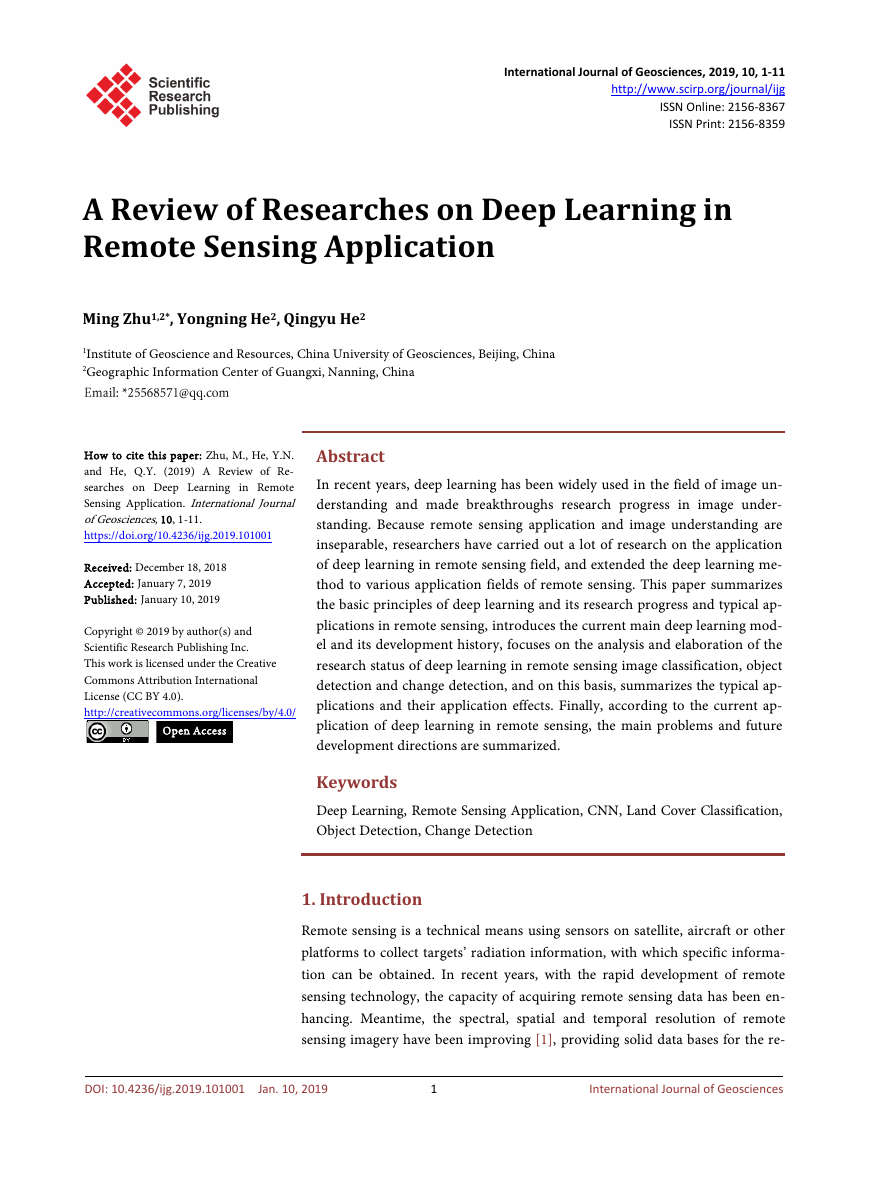
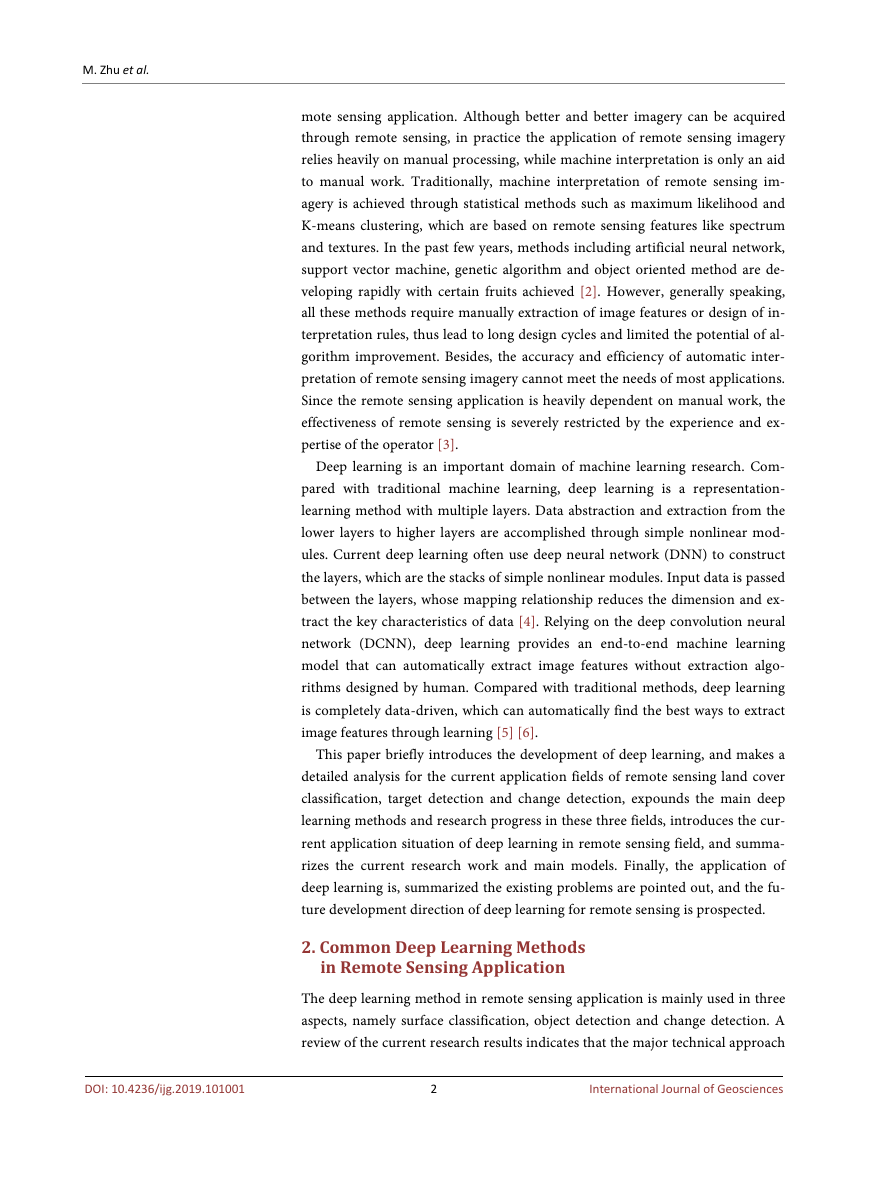
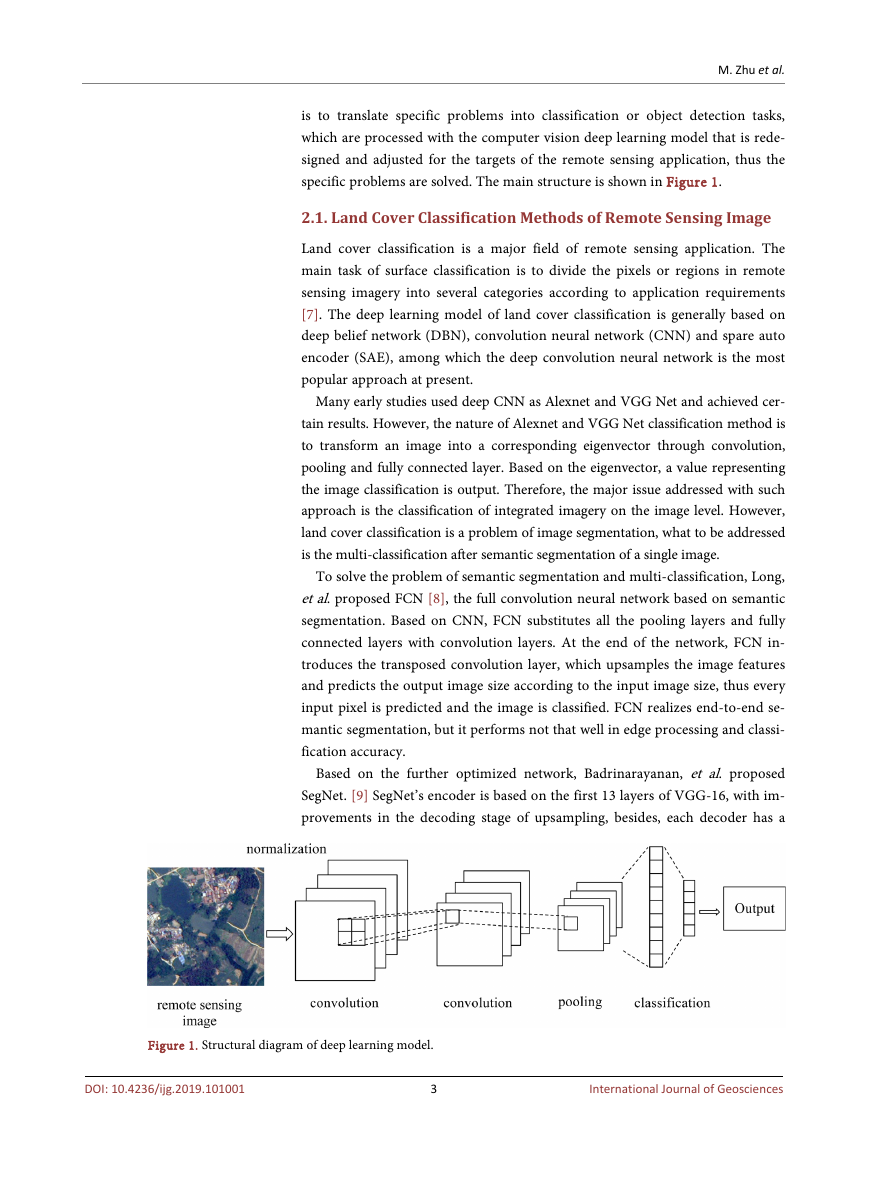
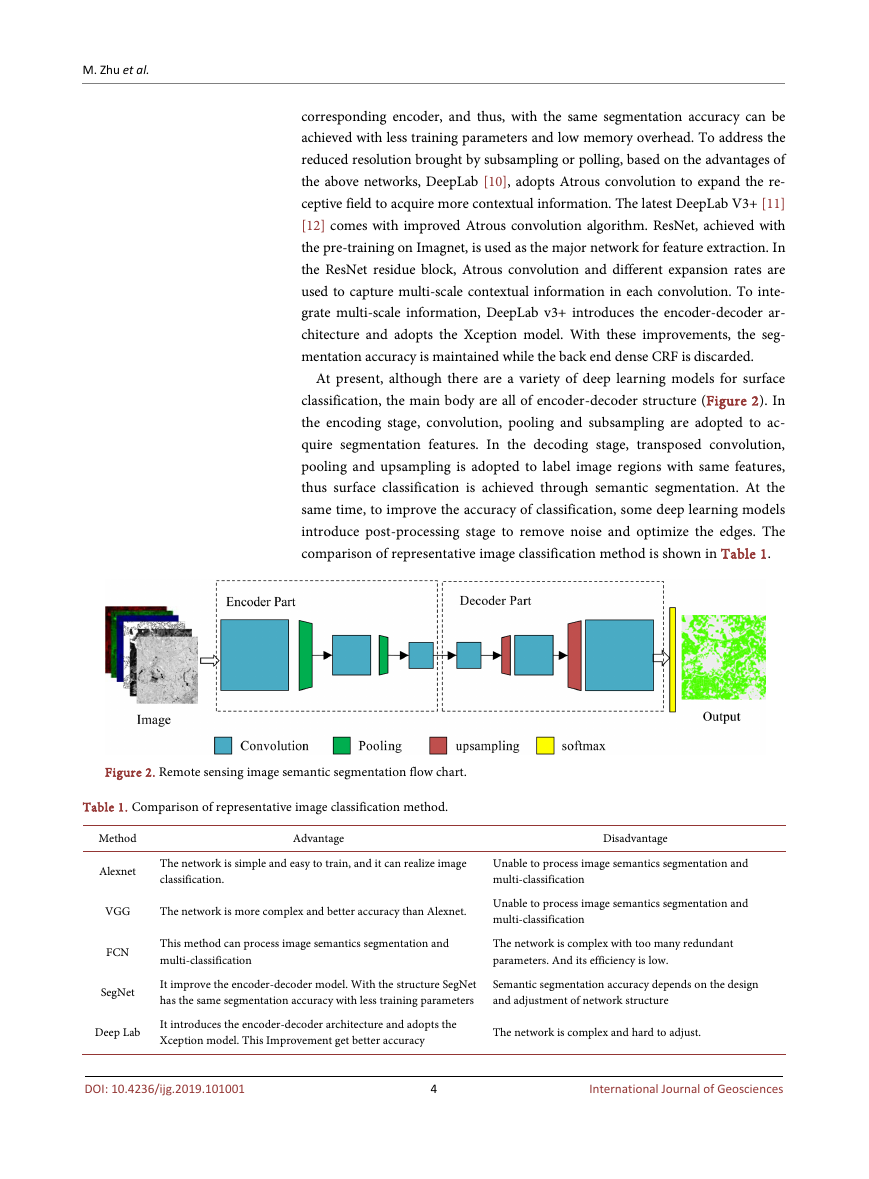
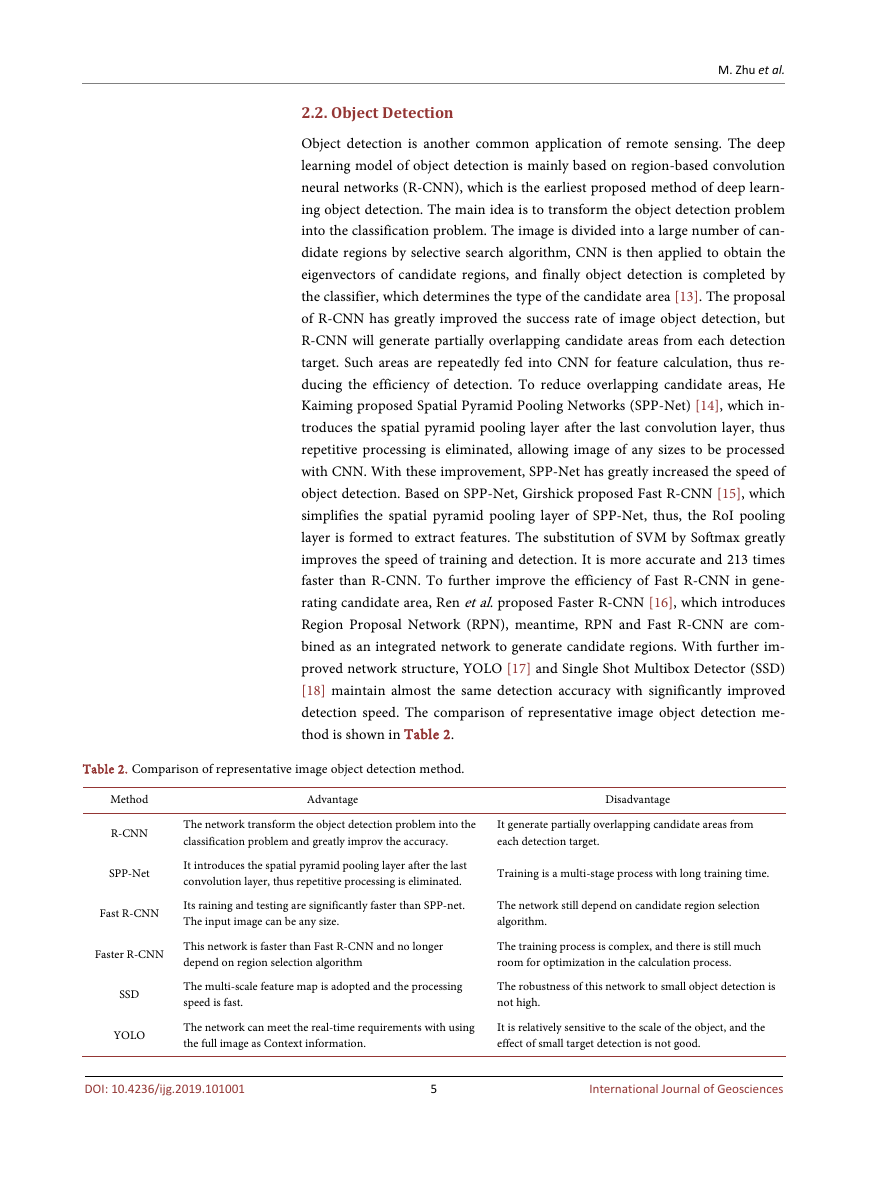
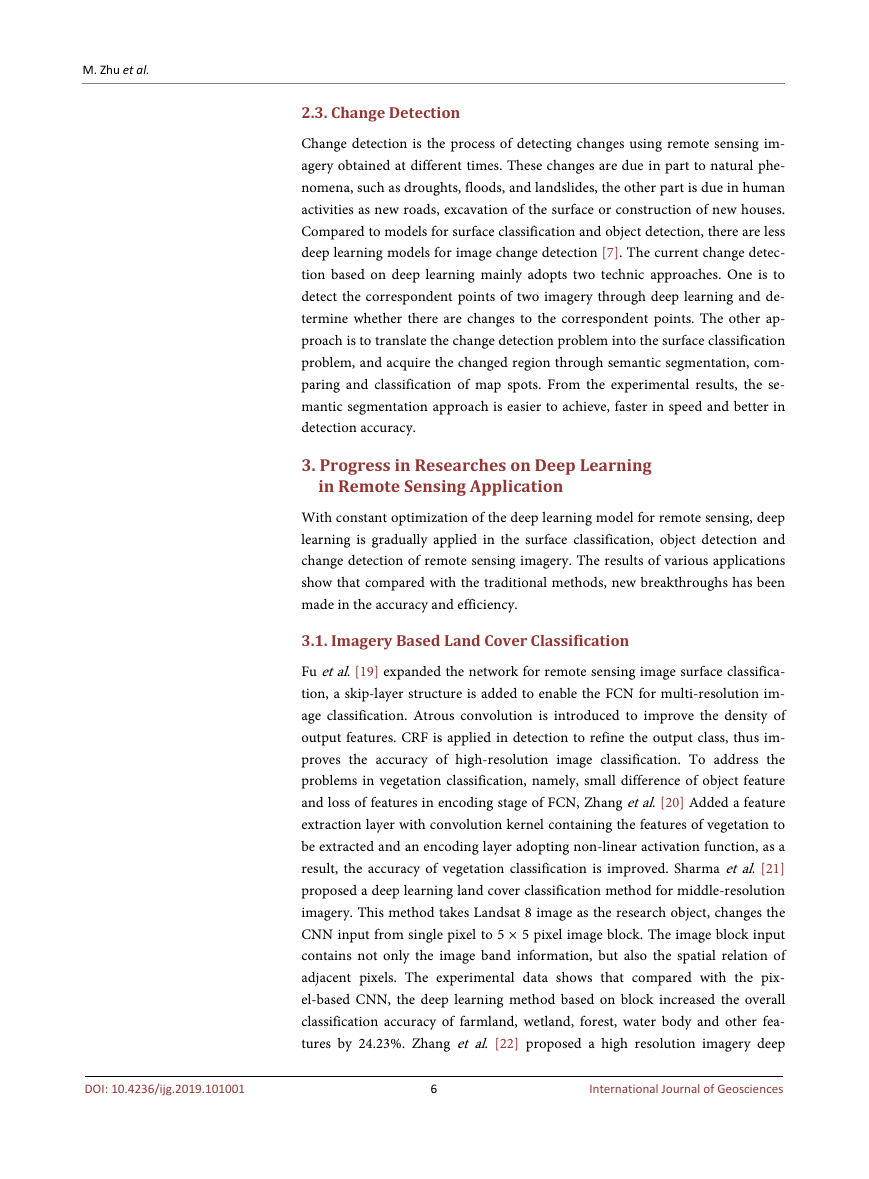
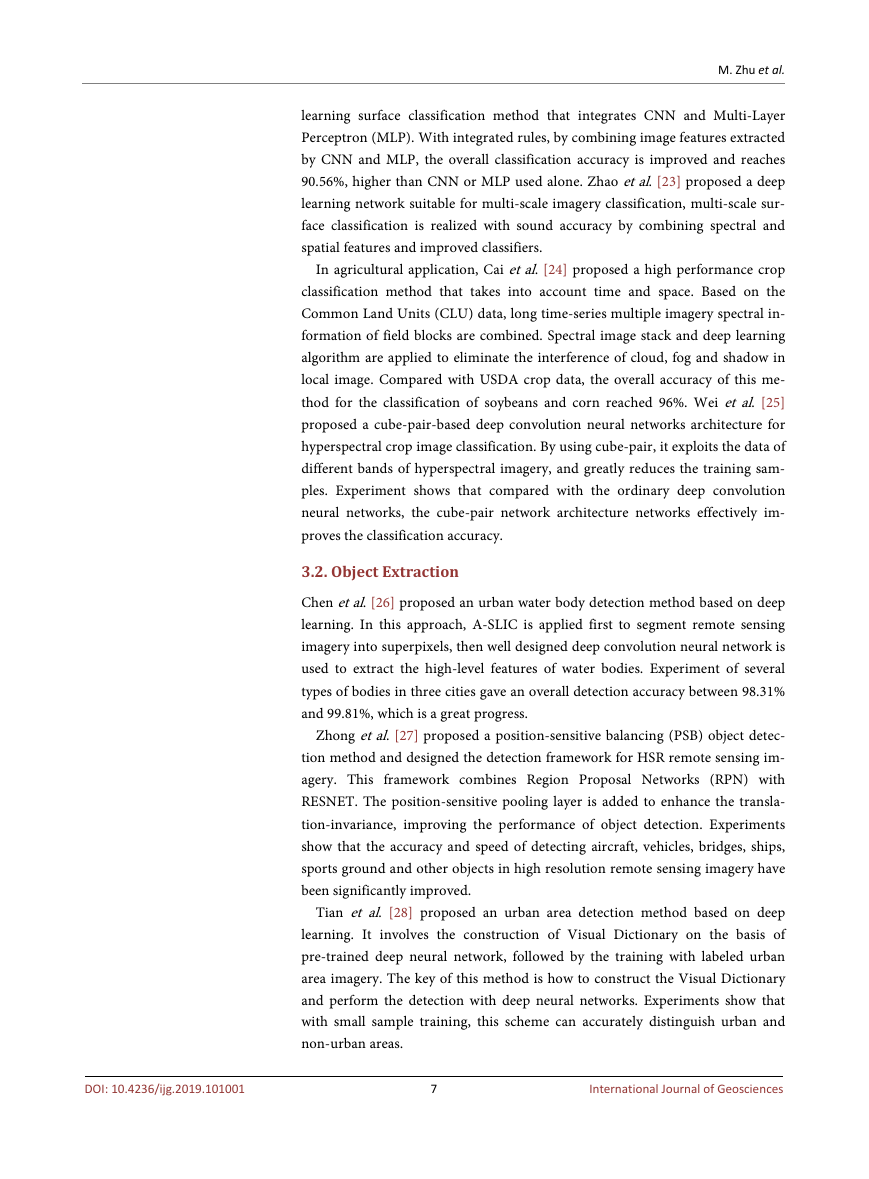









 2023年江西萍乡中考道德与法治真题及答案.doc
2023年江西萍乡中考道德与法治真题及答案.doc 2012年重庆南川中考生物真题及答案.doc
2012年重庆南川中考生物真题及答案.doc 2013年江西师范大学地理学综合及文艺理论基础考研真题.doc
2013年江西师范大学地理学综合及文艺理论基础考研真题.doc 2020年四川甘孜小升初语文真题及答案I卷.doc
2020年四川甘孜小升初语文真题及答案I卷.doc 2020年注册岩土工程师专业基础考试真题及答案.doc
2020年注册岩土工程师专业基础考试真题及答案.doc 2023-2024学年福建省厦门市九年级上学期数学月考试题及答案.doc
2023-2024学年福建省厦门市九年级上学期数学月考试题及答案.doc 2021-2022学年辽宁省沈阳市大东区九年级上学期语文期末试题及答案.doc
2021-2022学年辽宁省沈阳市大东区九年级上学期语文期末试题及答案.doc 2022-2023学年北京东城区初三第一学期物理期末试卷及答案.doc
2022-2023学年北京东城区初三第一学期物理期末试卷及答案.doc 2018上半年江西教师资格初中地理学科知识与教学能力真题及答案.doc
2018上半年江西教师资格初中地理学科知识与教学能力真题及答案.doc 2012年河北国家公务员申论考试真题及答案-省级.doc
2012年河北国家公务员申论考试真题及答案-省级.doc 2020-2021学年江苏省扬州市江都区邵樊片九年级上学期数学第一次质量检测试题及答案.doc
2020-2021学年江苏省扬州市江都区邵樊片九年级上学期数学第一次质量检测试题及答案.doc 2022下半年黑龙江教师资格证中学综合素质真题及答案.doc
2022下半年黑龙江教师资格证中学综合素质真题及答案.doc